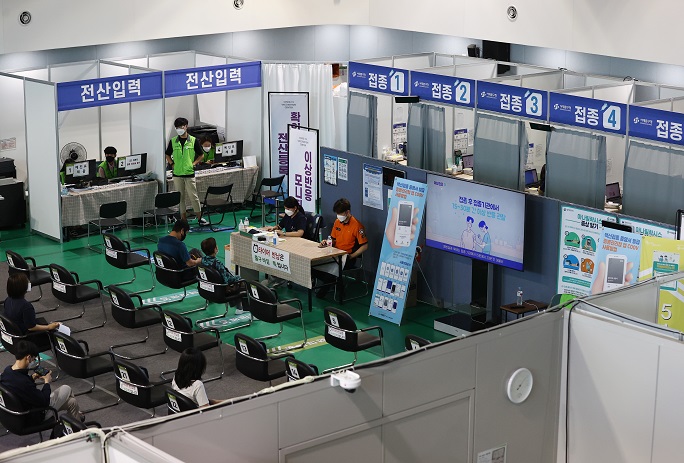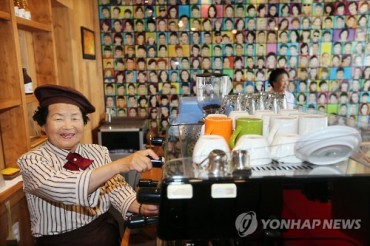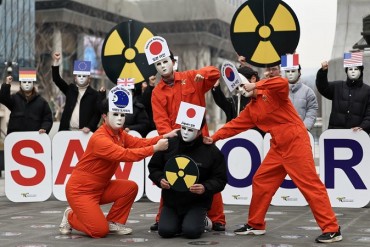
People wait to check for symptoms of possible side-effects from COVID-19 shots at a makeshift clinic at a gym in western Seoul on Sept. 3, 2021. (Yonhap)
SEOUL, Sept. 3 (Korea Bizwire) — South Korea’s daily new coronavirus cases are likely to stay in the 1,800s on Saturday as the greater Seoul area reported a surge in cases.
As of 9 p.m. Friday, 1,744 new cases were reported across the country, according to health authorities and local governments. Daily new cases are counted until midnight and announced the following morning.
The tally was up 92 from the same time the previous day and up 115 from the same time a week earlier.
The greater Seoul area reported 1,221 new cases, accounting for 70 percent of the total, with 523 new cases reported in other areas.
Early in the day, the Korea Disease Control and Prevention Agency (KDCA) reported 1,709 more COVID-19 cases, including 1,675 local infections, raising the total caseload to 257,110.
It marked a slight drop from the 1,961 tallied Thursday. Daily cases have stayed above 1,000 for 59 consecutive days.
The country added five more deaths from COVID-19, raising the death toll to 2,308, the KDCA said. The fatality rate came to 0.9 percent.
The number of patients with serious symptoms across the country reached 367, down four from the previous day.
South Korea said the existing distancing measures have helped the country contain any further spread of the virus to some extent, but the guidelines cannot be loosened due to the more contagious variants of COVID-19, including the delta strain.
Accordingly, health authorities decided to maintain the current social distancing measures — Level 4 in the capital area and Level 3 in other regions — through Oct. 3 to brace for Chuseok, the Korean equivalent of Thanksgiving, which runs from Sept. 18-22.
Regional governments can also adopt their own Level 4 guidelines, depending on their local situations.
Some of the restrictions, however, will be lifted, according to the government.
While South Korea has been banning gatherings of more than four people nationwide, health authorities said it has decided to allow gatherings of up to six in the capital area, although they should include at least two vaccinated people during the daytime and four after 6 p.m.
Gatherings of up to eight participants will be allowed over Chuseok as well.
Areas under Level 3 can also have gatherings of eight, if they include at least four fully vaccinated people.
Other updated measures include allowing restaurants and bars in the greater Seoul area to operate until 10 p.m. from the current restriction of 9 p.m.
Train operators will be only allowed to sell window seats over the holiday.
“We have decided to adjust social distancing guidelines to maintain both antivirus efforts and the economy,” Health Minister Kwon Deok-cheol said during a daily briefing.
“We plan to announce social distancing rules that can further normalize everyday lives in October.”
“Before the effect of the inoculation program kicks in, we need to maintain social distancing and follow antivirus rules to curb further infections,” Kwon added.
Health authorities, meanwhile, said South Korea’s daily new virus cases are expected to reach a peak of 2,300 through Sept. 23, before falling gradually.
The KDCA, meanwhile, said it has found three cases of the ‘mu’ COVID-19 variant here from arrivals from Mexico, the United States and Colombia.
South Korea has been raising its guard against variant cases and plans to order arrivals from Peru and Chile to go through a seven-day quarantine at designated facilities amid the looming spread of the lambda COVID-19 variant, starting Sept. 10.
“We still need to monitor the infection and fatality rate of the mu variant,” an official from the KDCA said.
A total of 29.6 million people, or 57.7 percent of the population, have received their first shots of COVID-19 vaccines, and 16.7 million people, or 32.7 percent, have been fully vaccinated, the KDCA said.
The country plans to provide at least one jab to 70 percent of the population by the end of September to create herd immunity in November. South Korea’s inoculation program, however, recently has been challenged by a delayed supply of shots.
Health authorities, meanwhile, claimed the country is expected to reach the target on time, pointing out an additional batch of 905,000 doses of Moderna’s vaccine will arrive here Friday.
Of the newly confirmed domestic cases, 540 were from Seoul, 513 from the surrounding Gyeonggi Province and 115 from the western port city of Incheon, the authorities said.
The southeastern port city of Busan added 58 cases, and South Chungcheong Province reported 77 more. The southwestern city of Gwangju found 41 new patients.
Imported cases, which include South Korean nationals, came to 34.
Arrivals from the United States accounted for six, with the Philippines, Uzbekistan, Kazakhstan and Russia taking up four each.
Over the past two weeks, around 35 percent of newly added patients here had unknown transmission routes. Cluster infections accounted for 13 percent.
The total number of people released from quarantine after making full recoveries was 228,618, up 2,396 from the previous day. Around 89 percent of the patients have been fully cured.
South Korea has carried out 13,286,682 COVID-19 tests so far, including 63,167 the previous day.
(Yonhap)







